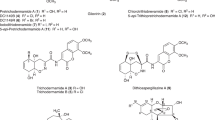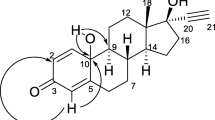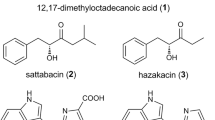Abstract
The conversion of β-myrcene to the furanoid flavour compound perillene by Pleurotus ostreatus was investigated using trideutero β-myrcene, trideutero α-(Z)-acaridiol and non-labeled 1,2- and 3,10-epoxy-β-myrcene, α,α-acarilactol, and perillene as substrates. Myrcene diols were formed from the cleavage of myrcene epoxides, but only α-(Z)-acaridiol, a 1,4-butanediol derivative most likely generated through a base-catalysed epoxide opening, was a suitable precursor of perillene. Once formed, this key intermediate was rapidly oxidised and the resulting cyclic lactol was dehydrated to yield perillene. Bioconversion of the supplemented perillene to α,α-acariolide indicated that perillene was another intermediate of the pathway and prone to further oxidative degradation. The data suggest that the fungus converted the cytotoxic β-myrcene in its environment into a metabolically useable carbon source along this route.




Similar content being viewed by others
References
Başer KHC, Demirci B, Dönmez AA (2003) Composition of the essential oil Perilla frutescens (L.) britton from Turkey. Flavour Fragr J 18:122–123
Biernacki W, Facile A (1980) Synthesis of methyl (±)-10,11-epoxy-3,7,11-trimethyldodeca-2,6-dienoate, the insect juvenile hormone III. Pol J Chem 54:777–780
Bohlmann F, Zdero C, Jakupovic J, Rourke JP (1985) cis-Guajanolide aus Osmitopsis asteriscoides. Liebigs Ann Chem 12:2342–2351
Busmann D, Berger RG (1994) Conversion of myrcene by submerged cultured basidiomycetes. J Biotechnol 37:39–43
De Vries EJ, Janssen DB (2003) Biocatalytic conversion of epoxides. Curr Opin Biotechnol 14:414–420
Faber K (2004) Biotransformations in organic chemistry. Springer, Berlin
Hua D, Ma C, Song L, Zhang Z, Deng Z, Xu P (2007) Enhanced vanillin production from ferulic acid using adsorbent resin. Appl Microbiol Biotechnol 74:783–790
Krings U, Berger RG (1998) Biotechnological production of flavours and fragrances. Appl Microbiol Biotechnol 49:1–8
Krings U, Hapetta D, Berger RG (2008) Bioconversion of b-myrcene to perillene by Pleurotus ostreatus. Biocatal Biotransform (in press)
Kuwahara Y (1990) Preparation of monoterpene derivatives as agrichemical fungicides. JP patent 02286640 A
Leal WS, Kuwahara Y, Nakano Y, Nakao H, Suzuki T (1989) 2(E)-(4-Methyl-3-pentyl)-butandial, α-acaridial, a novel monoterpene from the Acarid mite Tyrophagus perniciosus (Acarina, Acaridae). Agric Biol Chem 53:1193–1196
Miyazawa M, Ohsawa M (2002) Biotransformation of α-terpineol by the larvae of common cutworm (Spodoptera litura). J Agric Food Chem 50:4916–4918
Mizoguchi A, Mori N, Nishida R, Kuwahara Y (2003) α-Acaridial a female sex pheromone from an alarm pheromone emitting mite Rhizoglyphus robini. J Chem Ecol 29:1681–1690
Ohloff G (1994) Scent and fragrances. Springer, Berlin, Germany
Ohloff G, Giersch W (1980) Stereochemistry-activity relationships in olfaction. Odorants containing a proton donor/proton acceptor unit. Helv Chim Acta 63:76–94
Onken J, Berger RG (1999) Effects of R-(+) limonene on submerged cultures of the terpene transforming basidiomycete Pleurotus sapidus. J Biotechnol 69:163–168
Pinkos R, Fischer R, Müller U (1994) Verfahren zur Herstellung von Butendiolen und Butendiol-Derivaten in Gegenwart oxidischer Katalysatoren. DE patent 4429699 A1
Rito-Polomares M, Negrete A, Miranda L, Flores C, Galindo E, Serrano-Carreón L (2001) The potential application of aqueous two-phase systems for in situ recovery of 6-pentyl-α-pyrone produced by Trichoderma harzianum. Enz Microb Technol 28:625–631
Schewe H, Pescheck M, Sell D, Schrader J (2006) Biotechnological production of terpenoid flavour and fragrance compounds in tailored bioprocesses. In: Bredie WLP, Petersen MA (eds) Flavour science. Elsevier, Amsterdam, The Netherlands, pp 45–48
Schneider C (2006) Synthesis of 1,2-difunctionalised fine chemicals through catalytic, enantioselective ring-opening reactions of epoxides. Synthesis 23:3919–3944
Schrader J (2007) Microbial flavour production. In: Berger RG (ed) Flavour and fragrances. Springer, Berlin, pp 507–566
Schrader J, Berger RG (2001) Biotechnological production of terpenoid flavor and fragrance compounds. In: Rehm HJ (ed) Biotechnology. Wiley, Weinheim, Germany, pp 747–422 vol. 10: special processes
Shimizu N, Tarui H, Mori N, Nishida R (2003) (E)-2-(2-Hydroxyethylidene)-6-methyl-5-heptenal (α-acariolal) and (E)-2-(2-hydroxyethyl)-6-methyl-2,5-heptadienal (β-acariolal), two new types of isomeric monoterpenes from Caloglyphus polyphyllae (Acari: Acaridae). Biosci Biotechnol Biochem 67:308–313
Smit MS (2004) Fungal epoxide hydrolases: new landmarks in sequence-activity space. Trends Biotechnol 22:123–129
\Steinreiber A, Faber K (2001) Microbial epoxide hydrolases for the preparative biotransformations. Curr Opin Biotechnol 12:552–558
Suzuki T, Haga K, Kuwahara Y (1986) Anal secretion of thrips I. Identification of perillene from Leeuwenia pasanii (Thysanoptera: Phlaeothripidae). Appl Ent Zool 21:461–466
Tarui H, Mori N, Ritsuo N, Okabe K, Kuwahara Y (2002) 3-(4-Methyl-3-pentenyl)-2(5H)-furanone, α,α-acariolide and 4-(4-methyl-3-pentenyl)-2(5H)-furanone, α,β-acariolide: New monoterpene lactones from the astigmatid mites, Schwiebea araujoae and Rhizoglyphus sp. (Astigmata: Acaridae). Biosci Biotechnol Biochem 66:135–140
Taskova RM, Zorn H, Krings U, Berger RG (2006) A comparison of cell wall disruption techniques for the isolation of intracellular metabolites from Pleurotus and Lepista sp. Z Naturforsch C 61:347–350
Wolken AM, ten Have R, van der Werf MJ (2000) Amino-acid-catalyzed conversion of citral: cis–trans isomerization and its conversion into 6-methyl-5-hepten-2-one and acetaldehyde. J Agric Food Chem 48:5401–5405
Yuba A, Yazaki K, Tabata M, Honda G, Croteau R (1996) cDNA cloning, characterization and functional expression of 4S-(−)-limonene synthase from Perilla frutescens. Arch Biochem Biophys 21:280–287
Acknowledgement
We are grateful for a grant from the Deutsche Forschungsgemeinschaft (DFG KR 2958/1-1).
Author information
Authors and Affiliations
Corresponding author
Rights and permissions
About this article
Cite this article
Krings, U., Hapetta, D. & Berger, R.G. A labeling study on the formation of perillene by submerged cultured oyster mushroom, Pleurotus ostreatus . Appl Microbiol Biotechnol 78, 533–541 (2008). https://doi.org/10.1007/s00253-007-1335-8
Received:
Revised:
Accepted:
Published:
Issue Date:
DOI: https://doi.org/10.1007/s00253-007-1335-8




